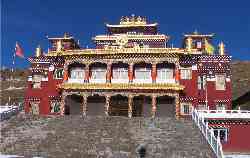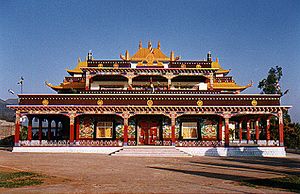Dzogchen Monastery: Difference between revisions
mNo edit summary |
mNo edit summary |
||
| Line 1: | Line 1: | ||
[[Image:Dzogchen.jpg|frame|The newly built temple at Dzogchen Monastery in Eastern Tibet, photo courtesy of Matthew Pistono]] | [[Image:Dzogchen.jpg|frame|The newly built temple at Dzogchen Monastery in Eastern Tibet, photo courtesy of Matthew Pistono]] | ||
'''Dzogchen Monastery''' ([[Wyl.]] ''rdzogs chen dgon pa''), '''Rudam Orgyen Samten Chöling''', one of the [[Six "Mother" Nyingma Monasteries]] of Tibet, was founded by [[Dzogchen Pema Rigdzin]] (1625-1697) in 1675 (according to the Great Tibetan Dictionary) or 1684 (according to [[Jamyang Khyentse Wangpo]]). It became especially renowned for its [[Shri Singha Shedra]] established by [[Gyalsé Shenpen Thayé]] during the time of the Fourth Dzogchen Rinpoche [[Mingyur Namkhé Dorje]], shortly after the monastery was almost totally destroyed by an earthquake in 1842. Among the great masters to have lived and taught at Dzogchen are [[Khenpo Pema Vajra]], [[Patrul Rinpoche]], [[Mipham Rinpoche]] and [[Khenpo Shenga]]. | '''Dzogchen Monastery''' (Tib. རྫོགས་ཆེན་དགོན་པ་, [[Wyl.]] ''rdzogs chen dgon pa''), '''Rudam Orgyen Samten Chöling''', one of the [[Six "Mother" Nyingma Monasteries]] of Tibet, was founded by [[Dzogchen Pema Rigdzin]] (1625-1697) in 1675 (according to the Great Tibetan Dictionary) or 1684 (according to [[Jamyang Khyentse Wangpo]]). It became especially renowned for its [[Shri Singha Shedra]] established by [[Gyalsé Shenpen Thayé]] during the time of the Fourth Dzogchen Rinpoche [[Mingyur Namkhé Dorje]], shortly after the monastery was almost totally destroyed by an earthquake in 1842. Among the great masters to have lived and taught at Dzogchen are [[Khenpo Pema Vajra]], [[Patrul Rinpoche]], [[Mipham Rinpoche]] and [[Khenpo Shenga]]. | ||
During the time of the [[Fifth Dzogchen Rinpoche]] (1872-1935), Dzogchen Monastery was at the peak of its activity, with up to five hundred monks residing, 13 retreat centres, and an estimated two hundred and eighty branches - a gathering of which would have seen tens of thousands of lamas, [[tulku]]s, khenpos, monks and nuns. Throughout the year, an extensive array of complex ritual ceremonies were accomplished. Dzogchen was also one of the most famous centres of sacred ritual dance, now commonly known as lama dancing. | During the time of the [[Fifth Dzogchen Rinpoche]] (1872-1935), Dzogchen Monastery was at the peak of its activity, with up to five hundred monks residing, 13 retreat centres, and an estimated two hundred and eighty branches - a gathering of which would have seen tens of thousands of lamas, [[tulku]]s, khenpos, monks and nuns. Throughout the year, an extensive array of complex ritual ceremonies were accomplished. Dzogchen was also one of the most famous centres of sacred ritual dance, now commonly known as lama dancing. | ||
| Line 16: | Line 16: | ||
==Further Reading== | ==Further Reading== | ||
===In Tibetan=== | ===In Tibetan=== | ||
*Gyalwang Nyima, ''mdo khams rdzogs chen dgon gyi lo rgyus nor bu’i phreng ba'' | *Gyalwang Nyima, མདོ་ཁམས་རྫོགས་ཆེན་དགོན་གྱི་ལོ་རྒྱུས་ནོར་བུའི་ཕྲེང་བ་, ''mdo khams rdzogs chen dgon gyi lo rgyus nor bu’i phreng ba'' | ||
:{{TBRC|W23714|མདོ་ཁམས་རྫོགས་ཆེན་དགོན་གྱི་ལོ་རྒྱུས་ནོར་བུའི་ཕྲེང་བ་, ''mdo khams rdzogs chen dgon gyi lo rgyus nor bu’i phreng ba''}} | |||
===In English=== | ===In English=== | ||
Revision as of 11:35, 23 February 2011

Dzogchen Monastery (Tib. རྫོགས་ཆེན་དགོན་པ་, Wyl. rdzogs chen dgon pa), Rudam Orgyen Samten Chöling, one of the Six "Mother" Nyingma Monasteries of Tibet, was founded by Dzogchen Pema Rigdzin (1625-1697) in 1675 (according to the Great Tibetan Dictionary) or 1684 (according to Jamyang Khyentse Wangpo). It became especially renowned for its Shri Singha Shedra established by Gyalsé Shenpen Thayé during the time of the Fourth Dzogchen Rinpoche Mingyur Namkhé Dorje, shortly after the monastery was almost totally destroyed by an earthquake in 1842. Among the great masters to have lived and taught at Dzogchen are Khenpo Pema Vajra, Patrul Rinpoche, Mipham Rinpoche and Khenpo Shenga.
During the time of the Fifth Dzogchen Rinpoche (1872-1935), Dzogchen Monastery was at the peak of its activity, with up to five hundred monks residing, 13 retreat centres, and an estimated two hundred and eighty branches - a gathering of which would have seen tens of thousands of lamas, tulkus, khenpos, monks and nuns. Throughout the year, an extensive array of complex ritual ceremonies were accomplished. Dzogchen was also one of the most famous centres of sacred ritual dance, now commonly known as lama dancing.
Its main temple was destroyed by fire in the second month of the Fire Mouse year (1936). It was rebuilt and then the whole monastery was destroyed by the Chinese in the late 1950s.
Dzogchen Monastery in India

Following the destruction of the monastery in the late 1950s, during which the complex was burnt to the ground for a second time in its history, it was re-established in South India according to the directions of His Holiness the Dalai Lama. The site was chosen personally by His Holiness, on land close to his own Dhondenling residence. Work began in 1985, three hundred years after the completion of the original Dzogchen Monastery in eastern Tibet.
In January 1992, the Dalai Lama formally inaugurated the new Dzogchen Monastery and gave teachings and empowerments over 11 days. Several thousand attended from the local community and from other monasteries and settlements in South India. His Holiness gave much advice for the monastery and the community, and pointed out that the work of the outer monastery was complete - meaning the buildings and a gathering of monks - and that now the work of the inner monastery could begin.
Now firmly re-established at the Dhondenling Tibetan settlement in Kollegal, South India, Dzogchen Monastery is the official seat of the seventh incarnation of the Dzogchen Rinpoche. In December 2000, His Holiness visited the monastery and settlement bestowing teachings and blessings for the lamas, monks, nuns, people of Dhondenling and others who had travelled from throughout all parts of India, Nepal, Australia, Europe, Singapore, the USA and Canada. At the busiest times during the visit up to 10,000 people gathered.
Further Reading
In Tibetan
- Gyalwang Nyima, མདོ་ཁམས་རྫོགས་ཆེན་དགོན་གྱི་ལོ་རྒྱུས་ནོར་བུའི་ཕྲེང་བ་, mdo khams rdzogs chen dgon gyi lo rgyus nor bu’i phreng ba
 མདོ་ཁམས་རྫོགས་ཆེན་དགོན་གྱི་ལོ་རྒྱུས་ནོར་བུའི་ཕྲེང་བ་, mdo khams rdzogs chen dgon gyi lo rgyus nor bu’i phreng ba
མདོ་ཁམས་རྫོགས་ཆེན་དགོན་གྱི་ལོ་རྒྱུས་ནོར་བུའི་ཕྲེང་བ་, mdo khams rdzogs chen dgon gyi lo rgyus nor bu’i phreng ba
In English
- Ringu Tulku, Zog-chen Gon-pa' in Tibet Journal, Volume 1, No. 3 & 4, Autumn 1976
Internal Links
- Dzogchen Rinpoche Incarnation Line
- Dzogchen Pönlop Incarnation Line
- Dzogchen Gemang Incarnation Line
- Shri Singha Shedra